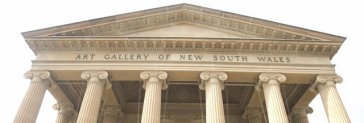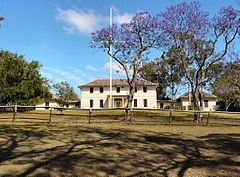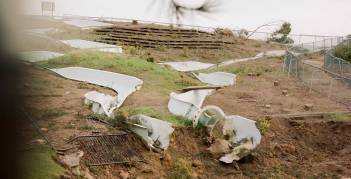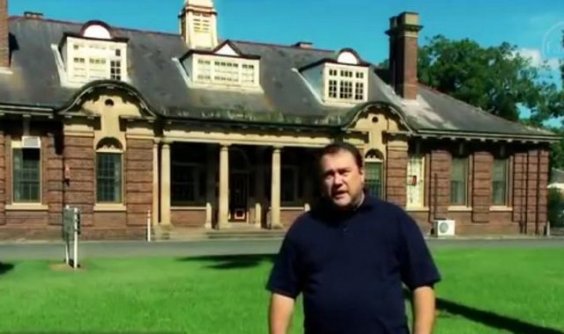Pressure grows for a complete rethink of the state government plans for the sale to developers of 20 hectares (two thirds) of the North Parramatta Heritage Precinct. The draft development control plan and development application are currently on exhibition by Parramatta Council until June 13. You can inspect them here. All submissions by that date will be considered before a final decision is made. In light of the continued appropriation of Parramatta Park lands by the state government since UrbanGowth’s plans for North Parramatta Heritage Precinct became public, there is yet another argument for a complete rethink of the “urban transformation project”. A brief glimpse of the treasures of the site is given on a YouTube video recorded by historian Dr Terry Smith, above.
 Among those supporting NPRAG’s campaign to save the site is internationally renowned author Thomas Keneally, left, and his daughter Meg, who is a direct descendant of a woman of the convict Parramatta Female Factory. Watch them on YouTube as they explain.
Among those supporting NPRAG’s campaign to save the site is internationally renowned author Thomas Keneally, left, and his daughter Meg, who is a direct descendant of a woman of the convict Parramatta Female Factory. Watch them on YouTube as they explain.
By chance I heard Michael Cathcart’s interview on ABC RN with author Judith White on May 10. She is a former executive director of the Art Gallery Society of NSW and her book is called Culture Heist: Art Versus Money. I was transfixed when he asked about her opinion that government appointed boards of NSW arts institutions “continue to play out the interests and values of the Rum Rebellion“. The 1808 rebellion, just 20 years after the establishment of the colony of New South Wales, was a coup by the military and property elite to protect their power and influence from control by the British government. Their self-appointed government lasted two years.
 Judith White believes those early attitudes of protecting power and influence are still systemic in NSW and distinguish the management of state government arts institutions from their now more successful counterparts in Victoria and Queensland. She doesn’t suggest that people start out with bad intentions, but rather that the power and influence of the business and property elite play out behind the scenes in NSW in subtle ways. She suggests that the NSW government gives priority to status in the corporate world of appointees to boards of directors rather than to their commitment and advocacy for the arts. It’s the same criticism made last year by former director of the Australian Museum, Dr Desmond Griffin, about appointments to governing boards of NSW cultural institutions. They lack experience in best museum practice.
Judith White believes those early attitudes of protecting power and influence are still systemic in NSW and distinguish the management of state government arts institutions from their now more successful counterparts in Victoria and Queensland. She doesn’t suggest that people start out with bad intentions, but rather that the power and influence of the business and property elite play out behind the scenes in NSW in subtle ways. She suggests that the NSW government gives priority to status in the corporate world of appointees to boards of directors rather than to their commitment and advocacy for the arts. It’s the same criticism made last year by former director of the Australian Museum, Dr Desmond Griffin, about appointments to governing boards of NSW cultural institutions. They lack experience in best museum practice.
Was this a clue to why it is that UrbanGrowth NSW seems so adept at conducting community consultations about the North Parramatta Heritage Precinct and then paying little attention to the results? Where are the advocates for history and heritage within the leadership? UrbanGrowth NSW is the agency responsible for developing and implementing the state government’s plans to subdivide and sell most of the North Parramatta site for “urban transformation” to high rise apartments for thousands of new residents.
 An interesting assessment of Parramatta’s transformation to “Australia’s next great city” and of the NSW government’s treatment of Parramatta Park and heritage sites appears in the landscape architects online publication Foreground. Paulette Wallace has a PhD in cultural heritage and international experience in the field. She writes, “One of the core issues with Parramatta’s transformation is that development appears to be placing state interests above local interests . . . Parramatta, it seems, is at risk of an enforced vibrancy, which gives the people what the government says they need, rather than what a democratically-elected council might implement in response to the demands of its constituents.”
An interesting assessment of Parramatta’s transformation to “Australia’s next great city” and of the NSW government’s treatment of Parramatta Park and heritage sites appears in the landscape architects online publication Foreground. Paulette Wallace has a PhD in cultural heritage and international experience in the field. She writes, “One of the core issues with Parramatta’s transformation is that development appears to be placing state interests above local interests . . . Parramatta, it seems, is at risk of an enforced vibrancy, which gives the people what the government says they need, rather than what a democratically-elected council might implement in response to the demands of its constituents.”
 The publicly owned green hectares of Parramatta Park extend around the World Heritage listed Old Government House (above) overlooking Parramatta River and the city. This year, the state government has already demolished Parramatta War Memorial Pool on the parkland (Foreground’s photo this month, right, of the ruins of Parramatta War Memorial Swimming Pool), in order to expand the adjoining Parramatta Stadium. While the previous Parramatta Council was complicit in this decision, the community was largely unaware until mid last year, by which time it was too late.
The publicly owned green hectares of Parramatta Park extend around the World Heritage listed Old Government House (above) overlooking Parramatta River and the city. This year, the state government has already demolished Parramatta War Memorial Pool on the parkland (Foreground’s photo this month, right, of the ruins of Parramatta War Memorial Swimming Pool), in order to expand the adjoining Parramatta Stadium. While the previous Parramatta Council was complicit in this decision, the community was largely unaware until mid last year, by which time it was too late.
No alternative plans had been developed for the thousands of regular pool patrons. It is  only their furious protests that have belatedly led to state and council’s recent commitments of million of dollars to build an alternative aquatic centre in the next five to seven years. In the meantime, the state government is preparing to annex the Mays Hill precinct of Parramatta Park for the proposed swim centre.
only their furious protests that have belatedly led to state and council’s recent commitments of million of dollars to build an alternative aquatic centre in the next five to seven years. In the meantime, the state government is preparing to annex the Mays Hill precinct of Parramatta Park for the proposed swim centre.
Desmond Griffin was scathing in his criticism of the proposal to relocate the Powerhouse Museum to Parramatta. No feasibility study or evaluation of cultural impact were conducted he said. He also said that NSW is the only state without a major history museum. This is an issue that has surfaced repeatedly in the community struggle to resist the proposed future development of the Parramatta North (Fleet Street) Heritage Precinct by the NSW Government. The 30 hectare site, across the Parramatta River from the Old Government House in Parramatta Park, is the site of some of the most significant elements of Australia’s colonial history and thousands of years of pre-colonial Aboriginal custodianship.
Another layer to NSW planning was added with the creation of the Greater Sydney Commission in 2015 by the NSW government. Chief commissioner Lucy Turnbull, is a business woman, former lord mayor of Sydney and wife of the Australian prime minister Malcolm Turnbull. She says, “In Parramatta, the amenity and cultural importance of places such as Centenary Square, Parramatta Square and Parramatta Park need to be recognised and protected. We must ensure the highest standards for Parramatta’s public spaces.”
 Now there are some glimmers of hope. After the abrupt departure of Premier Mike Baird in January this year, there are some encouraging signs that new premier Gladys Berejiklian may be listening a little more carefully. Her new minister for the arts Don Harwin, has announced community consultations about what the community wants of a new world-class museum for Parramatta (artist’s impression, left. Doubts have emerged about moving part or all of the Powerhouse collection from Sydney to Parramatta, to a council owned site on Parramatta River. Register to participate in consultations.
Now there are some glimmers of hope. After the abrupt departure of Premier Mike Baird in January this year, there are some encouraging signs that new premier Gladys Berejiklian may be listening a little more carefully. Her new minister for the arts Don Harwin, has announced community consultations about what the community wants of a new world-class museum for Parramatta (artist’s impression, left. Doubts have emerged about moving part or all of the Powerhouse collection from Sydney to Parramatta, to a council owned site on Parramatta River. Register to participate in consultations.
President of North Parramatta Residents Action Group, Suzette Meade says, “We will be presenting to the Arts Minister and the Premier our alternative vision, left, for this once in a lifetime opportunity to create a world class arts and cultural precinct at the Fleet Street  heritage precinct in North Parramatta. This is our chance to recognise that Parramatta is a highly unique and important piece of our state and country’s cultural heritage. Imagine the premier state not having a Museum of NSW.” The History Council of NSW supports the consultations.
heritage precinct in North Parramatta. This is our chance to recognise that Parramatta is a highly unique and important piece of our state and country’s cultural heritage. Imagine the premier state not having a Museum of NSW.” The History Council of NSW supports the consultations.
UrbanGrowth NSW is holding an open day at the Parramatta North site, 5 Fleet Street, Parramatta, on Saturday 27 May, 10am-4pm. They state it is “to allow the community to see what’s happening on the site and learn more about what’s planned over the next 7 to 10 years as we conserve, unlock and share the heritage of Parramatta North. See the archaeologists at work and view the artefacts on display. Discover what is being done to protect the local flying fox colony, and find out how the important heritage is being conserved.” Registration and information. Be prepared to ask the tough questions about where the high rise buildings will go and the proposed light rail route. North Parramatta Resident Action Group will also maintain a Save Our Heritage Vigil at the gates from 10am.
The Parramatta Female Factory Precinct Memory Project is presenting Long Time Coming Home, on the same day between 12pm-4pm. Enter via 1 Fleet Street, to explore the site’s indigenous legacy. Visitors are welcome to explore this historic child welfare institutional site.
















![1979493_10152047342291395_1452095453_n[1]](https://westsydneyfront.files.wordpress.com/2014/04/1979493_10152047342291395_1452095453_n1.jpg?w=196&h=300)
